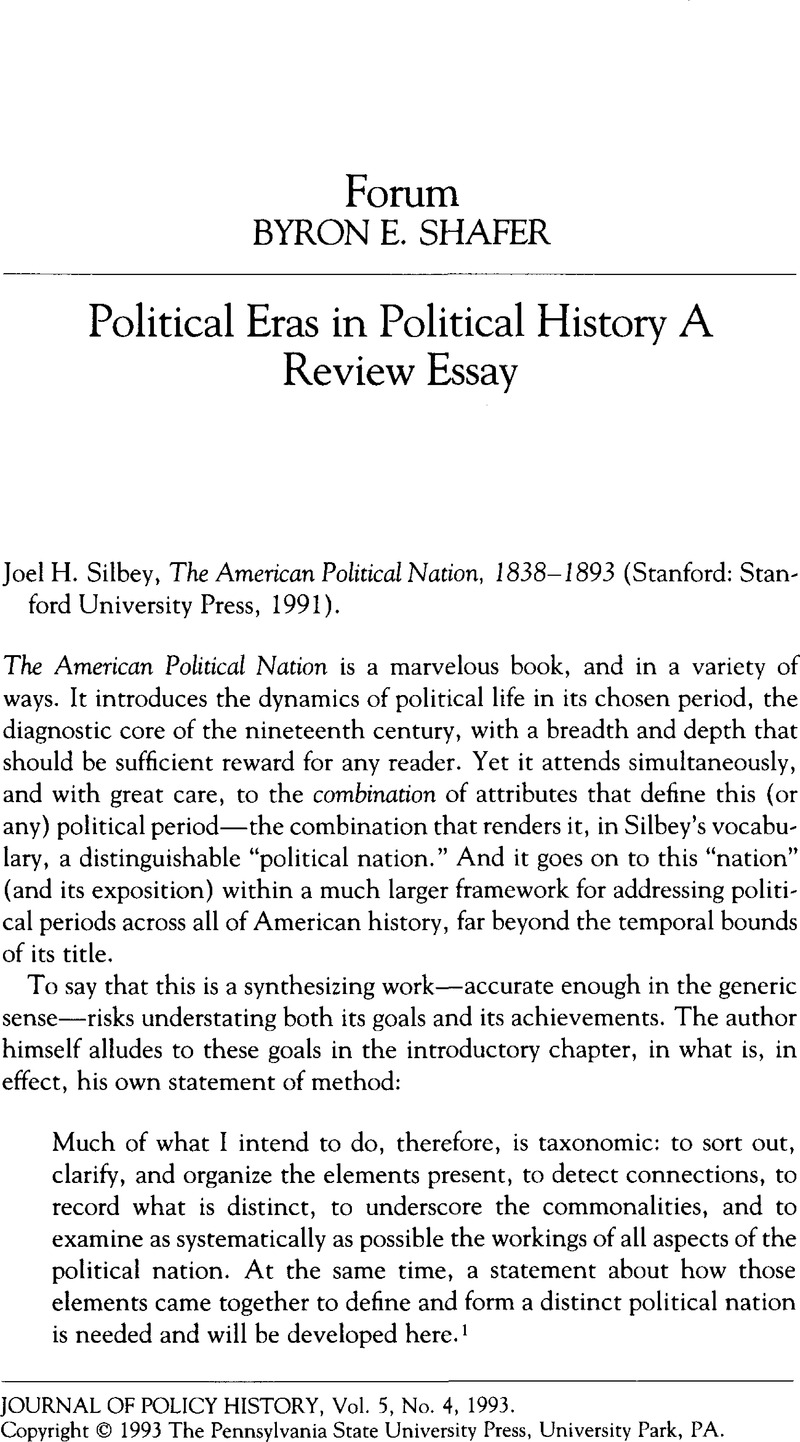Published online by Cambridge University Press: 14 October 2011

1. Silbey, The American Political Nation, 2.
2. Parallel works, at one remove, include Silbey, , A Respectable Minority: The Democratic Party in the Civil War Era, 1860–1868 (New York, 1978)Google Scholar, and Silbey, “Beyond Realignment and Realignment Theory: American Political Eras, 1789–1989,” chapter 1 in Shafer, Byron E., ed., The End of Realignment? Interpreting American Electoral Eras (Madison, Wis., 1991).Google Scholar
3. Silbey, The American Political Nation, 33.
4. Part of the title of chapter 5.
5. Landmark works would include, minimally: Key, V. O., Jr., “A Theory of Critical Elections,” Journal of Politics 17 (February 1955): 3–18CrossRefGoogle Scholar; Burnham, Walter Dean, Critical Elections and the Mainsprings of American Politics (New York, 1970)Google Scholar; and Sundquist, James L., Dynamics of the American Party System: Alignment and Realignment of Political Parties in the United Suites (Washington, D.C., 1973)Google Scholar. A richer sampling of the resultant corpus is Harold F. Bass, Jr., comp., “Background to Debate: A Reader's Guide and Bibliography,” the concluding section in Shafer, ed., The End of Realignment?
6. A collection of essays examining a number of alternative approaches to this analysis, from a point of view largely congenial with that of The American Political Nation, is McCormick, Richard L., The Party Period and Public Policy: American Politics from the Age of Jackson to the Progressive Era (New York, 1986)Google Scholar. Essays concentrating on an older notion of party systems, and then urging attention to the forces around and behind explicit politicking, are, respectively, William Nisbet Chambers, “Party Development and the American Mainstream,” and Samuel P. Hays, “Political Parties and the Community-Society Continuum,” both in Chambers and Burnham, Walter Dean, eds., The American Party Systems: Stages of Political Development (New York, 1967).Google Scholar
7. Silbey, The American Political Nation, 7.
8. An impressive attempt to reformulate in the face of this and succeeding conceptual problems is Clubb, Jerome M., Flanagan, William H., and Zingale, Nancy H., Partisan Realignment: Voters, Parties, and Government in American History (Beverly Hills, Calif., 1980)Google Scholar. A carefully delineated successor is Walter Dean Burnham, “Critical Realignment: Dead or Alive?” chapter 5 in Shafer, ed., The End of Realignment? And the sole sustained effort to provide a patterned phenomenon to drive regular realignments is Beck, Paul Allen, “A Socialization Theory of Partisan Realignment,” in Niemi, Richard D. et al., eds., The Politics of Future Citizens (San Francisco, 1974), 199–219Google Scholar, and Beck, , “The Electoral Cycles and Patterns of American Politics,” British Journal of Political Science 9 (April 1979): 129—CrossRefGoogle Scholar 56.
9. This argument is made forcefully by Richard L. McCormick, in a review essay of Chubb, Flanagan, and Zingale, Partisan Realignment, as “The Realignment Synthesis in American History,” Journal of Interdisciplinary History 13 (Summer 1982): 85–105CrossRefGoogle Scholar, reprinted in his The Party Period and Public Policy. An even grander elaboration of the argument is David R. Mayhew, “Domestic Policy Waves in Comparative Perspective,” chapter 3 in Lawrence C. Dodd and Calving Jillson, eds., Governing Processes and Social Change (Washington, D.C, forthcoming 1993).
10. Silbey, The American Political Nation, 7.
11. An elaboration of this hypothesis is Byron E. Shafer, “Political Structures, Political Orders, and Political Eras,” chap. 2 in Dodd and Jillson, eds., Governing Processes and Social Change.